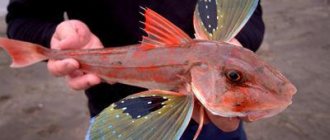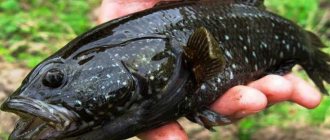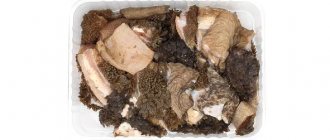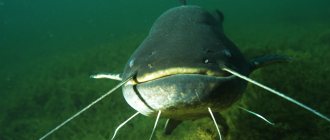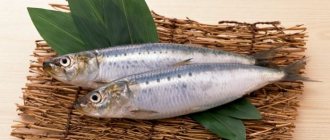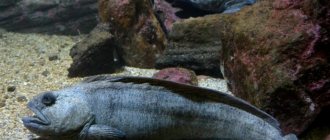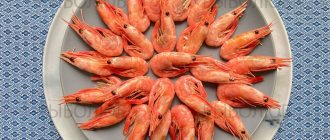Calorie content, composition, nutritional value
The energy value of Atlantic salmon depends on the method of processing the meat. Initially, the calorie content of a raw piece of salmon in 100 g is 140 kcal.
During cooking, this indicator changes as follows:
- in baked fish - 185.6 kcal;
- boiled - 180 kcal;
- steamed - 176.7 kcal;
- fried - 256.7 kcal;
- in salted food - 205.4 kcal;
- smoked - 202.5 kcal.
The chemical composition of salmon includes vitamins A, PP, B1, B2, C, E, D, as well as useful minerals: potassium, calcium, magnesium, iron, phosphorus and zinc.
Salmon is also distinguished by its high content of omega-3 fatty acids and iodine, which contribute to the proper functioning of all organs, strengthening the immune system and maintaining good health.
The nutritional value of salmon is characterized by the complete absence of carbohydrates in its composition.
How is salmon useful?
Salmon fish decorates any holiday table; it is not only the most delicious fish, but also the healthiest.
Fish meat is rich in vitamins and minerals, namely calcium, phosphorus, zinc, iodine, etc.
Carp fish - description, main types, useful properties, habitats, catching + 78 photos- Loach - fish lifestyle, nutrition, reproduction process + 71 photos
Pike - appearance, habitats, nutrition, varieties, spawning + 86 photos
Atlantic salmon is considered a fattier and higher-calorie fish than white fish. Salmon contains quite a lot of useful omega-3 acids, which are so necessary for the proper functioning of the human heart.
Healthy fish oil can lower cholesterol; consuming such fish will help improve visual function, support the functioning of the liver and nervous system, improve stomach function, and boost immunity.The beneficial components contained in salmon meat can prevent the risk of thrombosis.
Undoubtedly, this type of fish is loved by all people; lean meat is given even to small children aged one and a half years. Nutritionists recommend using low-fat varieties of fish as a dietary food.
Appearance of salmon
Salmon belongs to the salmon family, the ray-finned class. This is one of the largest representatives of its genus. Under natural conditions, it grows up to 1.5 m in length and can reach a weight of 40-45 kg. Such fish live up to 10-15 years.
Freshwater salmon are smaller in size and smaller in body weight. Adults can reach 15 kg with sufficient food in the reservoir.
What does salmon look like?
This fish has a number of common characteristics characteristic of the salmon family. The body of an adult is elongated and slightly flattened laterally. The skin is covered with silvery small scales that peel off easily.
The pectoral fins of Atlantic salmon are located below the midline. A special feature of representatives of this family is the presence of a small fin, which is located near the anus.
All over the salmon's body there are small dark spots that form the shape of the letter X.
The lower jaw of an adult protrudes forward and looks like a hook, and the upper jaw has a characteristic depression.
The age of a fish can be determined by the color of its scales. The body of young salmon is darker and has transverse spots. An adult has light scales on its back and an almost white belly. The body of a female preparing for spawning has a bronze tint with red spots.
Salmon fillet for your table.
How to distinguish salmon from trout by appearance
The difference between salmon and trout is primarily in size. The latter cannot grow more than 30 cm, and the maximum weight of this fish reaches only 2 kg. On her body there is a characteristic soft pink stripe with a pearlescent tint, which runs along the midline from head to tail.
When purchasing fillets of these salmon representatives, you can distinguish them by the color of their flesh. In trout it is bright pink, almost red. Salmon has a paler shade of pink, closer to orange.
Heat treatment also helps to accurately determine the name of the fish. The color of the salmon fillet practically does not change during the cooking process, but the trout becomes lighter, the shade of the flesh loses its richness.
How to choose salmon
When purchasing a whole carcass, you need to pay attention to the color of the gills: they should be pink, like the salmon flesh. A dark shade indicates the considerable age of the fish, and too bright a shade indicates the presence of artificial dyes. The pale hue and loose structure indicate that the fish has been frozen several times.
When choosing salted or smoked salmon, the production time of the product and the quality of packaging are important. The vacuum bag should be tight, with good air pumping. If the fish fillet returns to its original volume after pressing the flesh with your finger, it means that fresh fish was used to prepare the product.
What red fish should you not buy?
Roskoshestvo recommends looking at the color, structure of the fillet and preservatives if you buy salted fish. Take fish with a uniform color without spots, dark streaks or yellowness with an elastic fillet without a loose structure. Salt and small amounts of sorbic and benzoic acid are allowed in salted fish.
Russian legislation does not prohibit manufacturers from using dyes for red fish raised on farms. Unlike their free-living relatives, captive-bred fish become faded due to nutrition. Under natural conditions, its meat acquires its characteristic color due to red plankton.
How to store salmon
If Atlantic salmon is purchased for future use, it should only be stored in the refrigerator or freezer. Chilled fish should be placed in a bowl with crushed ice. This will help the salmon flesh stay juicy.
Smoked and salted Atlantic salmon in vacuum bags and plastic containers should be stored in the refrigerator without disturbing the integrity of the packaging and opening it only before eating the fish.
In the refrigerator, it is better to keep salmon wrapped in foil, away from other foods.
Salmon steaks should be stored in the refrigerator.
How are Atlantic salmon bred and raised?
To get tasty, fatty salmon meat, people began to grow this fish in artificial conditions, that is, in sea water, but in special cages. This method of growing fish is most developed in Chile and Norway.
Literally throughout the year, the fish reproduces and grows well, since all the conditions for its maintenance are met. The cost of such cultivation is quite high, so this method is not so well developed in Russia.
Medicinal properties of fish
The benefits of Atlantic salmon have long been appreciated by doctors in many areas. They recommend including it in the diet of people with cardiovascular problems, excess weight, and joint diseases.
With regular consumption of salmon (1-2 times a week), the following improvements are noted:
- brain functionality is activated;
- the walls of blood vessels are strengthened;
- weight loss is observed;
- the condition of bone tissue is normalized;
- the risk of developing atherosclerosis is reduced;
- muscle tissue is restored.
The vitamin and mineral composition of salmon is useful for cardiac patients and people with problems with the nervous system. The presence of unsaturated fatty acids helps remove bad cholesterol from the body and helps cleanse blood vessels.
Tesha: beneficial properties of bellies
Salmon bellies, also known as tesha, contain the most fish oil. Due to its affordable price, this ingredient is very popular among red fish lovers.
And for good reason, because the belly of salmon is no less beneficial than the loin of the fish. Tesha is a repository of a large supply of proteins and fats.
But it is worth limiting the consumption of this delicacy to people who have problems with the gallbladder and pancreas.
Use in cosmetology
Salmon caviar has found its application in the manufacture of professional cosmetics. This valuable product is used to create anti-aging creams for the face and body.
Benefits of salmon for facial skin
Extract from Atlantic salmon caviar is capable of:
- accelerate metabolic processes in skin cells;
- activate collagen production;
- promote regeneration and removal of free radicals.
Dermatologists recommend including salmon in the diet of people suffering from skin diseases. This fish helps reduce inflammation and accelerates skin regeneration.
Salmon habitat
This fish belongs to the diadromes. This is the name given to individuals that live in both fresh and salt waters, migrating periodically. Salmon lives in the northern part of the Atlantic Ocean and in the western part of the Arctic Ocean. This fish begins its life in fresh waters and moves to salt waters as it matures.
In Russia, Atlantic salmon is found in the northern seas:
- Barentsev;
- Karsky;
- White;
- Baltic.
The lake variety of salmon in our country lives in the reservoirs of the Kola Peninsula and Karelia.
Large volumes of fishing and the construction of hydraulic structures on rivers have led to a decline in the salmon population in Russia, which is why this fish was listed in the Red Book as a species declining in number.
To correct the situation, in the late 90s. XX century salmon began to be bred artificially to replenish the food market and restore the population in their habitats.
What does salmon eat in the wild?
At a young age, this fish feeds on small river and sea inhabitants. The diet of salmon includes crustaceans, plankton, and larvae. Adults that return to the sea after spawning hunt for shrimp, sprat, capelin and other small fish.
Salmon spawning
Depending on the habitat of salmon, sexual maturity of adults occurs in the 2-7th year of life. Atlantic salmon from the southern regions begin to spawn earlier than everyone else. Red fish living off the coast of Scotland and Canada mature 3-4 years later.
The spawning period begins in October and lasts until December. When entering rivers, salmon stops feeding and maintains its strength with the help of accumulated reserves.
Females lay eggs in loose soil. To do this, they dig a hole at the bottom with their tail, and when the male fertilizes her, they fill this place with silt. Such a nest can contain up to 25 thousand large eggs.
The transition to the spawning site and the process itself takes a lot of energy from Atlantic salmon. On the way back to the sea, some of the fish die. Those individuals that managed to return to salty waters quickly regain their strength and swim to the same river for the next spawning period.
Salmon fishing
Experienced fishermen advise catching the “queen of salmon” in the north and east of our country, in rivers with fast currents and rocky rapids. Salmon is a large specimen and cannot be found in small rivers. You should also pay attention to this when choosing a place to “hunt” for red fish.
The best time to catch salmon is from mid-summer to early autumn, depending on the region. In clear weather it is better to fish in the morning or evening, and in cloudy weather - in the afternoon.
Small fish are suitable as bait. An adult salmon has a considerable mass and strongly resists when hooked. Therefore, the gear must be durable, and the fisherman himself must be in good physical shape.
Summing up - which is better?
All representatives of the Salmon family have unique characteristics. Fish vary in taste, fat content, shade of meat, and number of bones. They also have different habitats. However, regardless of the type, these products contain many vitamins.
Moreover, each type of fish has unique taste qualities. Although salmon and trout are considered the most popular, it is worth trying them all. This will help you choose the appropriate option depending on your personal preferences.
Interesting facts about salmon
In the old days, the Atlantic salmon catch was so rich that this fish was not considered a delicacy. In Scotland, they fed farm laborers with it, so intensively that when hiring them, they specifically stipulated the conditions so that there would be as little salmon as possible.
Atlantic salmon is not only a unique food product, but also the hero of the short film “The Man Stalked by the Salmon.” This comedy won first prize at the Takeshi Kitano Dynamic Film Competition in 2007.
Salmon has a natural GPS navigator. In its body there are special nerve cells that react to the Earth’s magnetic field and are sent to spawn in its native river, where this adult itself hatched from a small egg.
Recipes with salmon
Atlantic salmon has a delicate sweetish taste. This delicious product can be baked, steamed, or fried when fresh. Salads, appetizers and sushi are made from smoked and salted salmon.
Fish is best served with vegetables, herbs, and eggs. Dishes prepared from salmon go well with sweet, sour and spicy sauces.
Salad
To prepare this dish you will need the following products:
- 200 g lightly salted salmon;
- 100 g avocado;
- 10 quail eggs;
- 100 g cream cheese;
- 1 cucumber.
Cut the fish into small slices. Divide the boiled quail eggs into 4 parts each. Remove the peel and pit from the avocado and cut into cubes along with the cucumber.
Place all ingredients in a bowl, add salt, squeeze lemon juice (0.5 tsp) on them, mix and season with soft cream cheese.
Lightly salted salmon is used in salads.
Salmon soup
This dish is the basis of a tasty and satisfying lunch. It is prepared from available products and does not take much time.
For this you need the following ingredients:
- salmon (fillet) - 650 g;
- potatoes - 500 g;
- carrots - 20 g;
- onion - 100 g;
- butter - 50 g.
For spices you will need salt, pepper, bay leaf and fresh herbs - a small bunch of dill.
The quantity of products is calculated for 2 liters of broth.
Cut the finished fish into small pieces, place in a saucepan with water, bring to a boil and reduce heat. Cut the onion in half and add to the salmon. Chop the potatoes into cubes and the carrots into circles.
Place the vegetables in a saucepan with the salmon and cook for 20 minutes, covered. Put butter, and after cooking add chopped dill to each plate with fish soup.
How to salt salmon at home
The advantage of this fish is that it cannot be oversalted. Fatty salmon takes salt in moderation. Prepared fish is used to prepare various appetizers, salads and sandwiches.
To properly salt salmon at home and not spoil this delicious product, you must adhere to the following recommendations:
- Do not use metal utensils for cooking fish.
- When salting a whole carcass, make cuts on it so that the salt evenly saturates the fish.
- Do not remove the skin first to make the fillet more juicy.
- Do not salt the salmon together with the head: it may not be salted. This part is best used for making fish soup.
To salt fish according to the classic recipe you will need:
- 500 g salmon fillet;
- 3 tbsp. l. salt;
- 3 tbsp. l. Sahara;
- 100 g fresh dill.
Wash and dry the fish, mix salt and sugar with finely chopped dill. Rub the fillet well with this mixture, place in a bowl and press under pressure for 6 hours. Then remove it and put the container with salmon in the refrigerator for a day.
Baking steaks in a slow cooker
For this dish you need to prepare 4 salmon steaks, a glass of whole milk with a high percentage of fat, 1 tbsp. l. lemon juice, olive oil, a clove of garlic, salt and pepper.
Rinse the salmon steaks under running water and dry with a paper towel. Place the fish pieces in a glass bowl and pour milk over them for half an hour. Salmon marinated in this way will become tender and juicy.
Prepare a mixture of lemon juice, salt, pepper and olive oil. Remove the fish from the milk and rub the steaks on all sides with the dressing. Leave for 10 minutes. During this time, chop the garlic and rub the salmon with it.
In the multicooker menu, select the “Baking” mode and set the timer for 30 minutes.
Pour 1 tbsp into the bowl. l. olive oil, spread it over the entire surface, place the steaks and cover. After 15 minutes, turn the fish over to the other side and cook until the timer beeps.
Steaks with golden brown crust are served with fresh herbs and lemon wedges. You can serve boiled rice or mashed potatoes as a side dish.
Steaks can be baked in a slow cooker.
How to fry in a frying pan
For this recipe you will need the following products:
- salmon fillet -700 g;
- wheat flour - 4 tbsp. l.;
- butter - 80 g;
- dry white wine - 100 ml;
- cream - 250 ml;
- salt, pepper - to taste.
Cut the fish fillet into several portions, rub with salt and pepper. Place 3 tbsp in a shallow bowl. l. flour, roll salmon pieces in it. Grease a heated frying pan with butter (50 g) and place the prepared fish on it. Fry on both sides for 5 minutes and then remove to a paper towel.
While the fish is resting a bit, prepare the sauce:
- Melt 30 g of butter in a saucepan.
- Mix it with 1 tbsp. l. flour and stir until smooth.
- Slowly pour in the cream and white wine.
- Cook the sauce over low heat while constantly stirring until thickened.
Serve fried salmon on lettuce leaves with creamy sauce.
Baked in the oven in foil
The simplest recipe with a minimum of ingredients. A good option for a healthy dinner. The dish cooks quickly and turns out delicious. It requires fish, lemon, salt, olive oil and foil.
Wash the salmon steaks, dry, salt and sprinkle with lemon juice. For each serving, prepare a separate sheet of foil, grease them with olive oil, and place the fish on them. Wrap the foil carefully, without pressing the salmon, so that there is free space.
Bake in an oven preheated to 180°C for 15-20 minutes. You can serve steamed vegetables as a side dish.
Sandwiches
There are many options for preparing this type of snack. Some will serve as decoration for the holiday table, others are suitable for breakfast.
According to any recipe, salmon sandwiches turn out bright, elegant and tasty:
- Lightly dry the pieces of whole grain bread in the oven. Mix cream cheese with chopped dill and brush the bread with it. Cut lightly salted salmon and fresh cucumber into cubes and mix with each other. Place the mixture of vegetables and fish on pieces of bread with cheese and garnish with dill branches.
- Peel the ripe avocado and remove the pit. Mash the pulp with a fork, add the juice of half a lime and ground black pepper and stir well. Cut the salted fillet into thin and long strips. The basis of these sandwiches is slices of wheat baguette. Spread each one with avocado paste. Roll the salmon strips into rolls and place 2 pieces each. for bread. Garnish them with dill and sesame seeds.
- Cut out various shapes from slices of white bread using homemade cookie cutters. Grease each piece with butter and place a thin slice of lemon and lightly salted salmon on them (you can take ready-made slices).
- Take smoked red fish, butter, French mustard, fresh dill and a pinch of fish spices. Chop the salmon with a knife and soften the butter at room temperature. Mix these ingredients, add chopped dill, mustard and spices. Spread the resulting mixture onto lightly dried slices of white bread and garnish with dill branches.
Salmon is a valuable and nutritious product. You can preserve all the beneficial qualities of this red fish by choosing the right cooking methods and following the rules for purchasing and storing it.
How to preserve all the benefits when cooking
In Russia, salmon is sold fresh, frozen and salted. It is optimal to purchase a chilled product - it retains more beneficial properties. When choosing a fish, you need to look at its color - if the flesh looks too bright, unnatural, you should refuse the purchase, since the fish may be dyed.
@murakumo28 pixabay.com
You can prepare many healthy dishes from fresh salmon. The only thing is that you shouldn’t fry it. Such heat treatment will saturate the healthy product with extra calories and make it harmful. It is better to grill steaks, bake fillets with some sauce or steam the fish. Keep in mind that the salmon should spend about 30-40 minutes in the oven at a temperature of 180 degrees, and steam or bake it for 20 minutes. These rules will make the product useful and eliminate the risk of infection by parasites that live in marine fish.
Salmon is a valuable red fish, the consumption of which can benefit the human body, provided that he is not obese. Periodic consumption of dishes made from the pulp of this fish helps to normalize metabolism and normalize the functioning of the cardiovascular and nervous systems.
